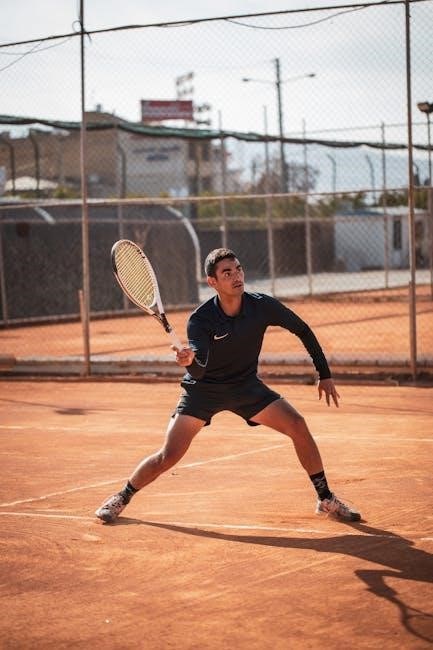The acl return to sport test pdf is a guideline for athletes to return to sports after injury, using a series of physical tests to assess readiness and ability to perform safely and effectively online.
Overview of the Test
The acl return to sport test pdf provides a comprehensive overview of the test, including its purpose and requirements.
The test is designed to assess an athlete’s readiness to return to sports after an injury,
with a focus on physical ability and safety.
The test consists of a series of physical assessments,
including single leg squats and broad jump,
which are used to evaluate an athlete’s strength,
power, and agility.
The test is typically administered by a healthcare professional,
such as a physical therapist or athletic trainer,
who will use the results to determine an athlete’s readiness to return to sports.
The test is an important tool for athletes,
coaches, and healthcare professionals,
as it helps to ensure that athletes are able to safely and effectively return to sports after an injury.
The test is also used to identify areas where an athlete may need to improve,
such as strength or agility,
in order to reduce the risk of further injury.
The acl return to sport test pdf is a valuable resource for anyone involved in sports or athletic training.

Components of the Test
The test includes physical assessments and evaluations using various methods and tools online successfully.
Single Leg Squats and Broad Jump
The single leg squats and broad jump are essential components of the test, evaluating an athlete’s strength, balance, and jumping ability.
These exercises are crucial in determining an athlete’s readiness to return to sports, as they require proper technique and execution to perform safely and effectively.
The single leg squat assesses an athlete’s ability to maintain balance and control on one leg, while the broad jump evaluates their explosive power and jumping ability.
Both exercises are performed on both the involved and uninvolved legs, allowing for comparison and evaluation of any differences in strength and function.
The results of these tests are used to determine an athlete’s progress and readiness to return to sports, with the goal of ensuring a safe and successful return to competition.
The test is typically administered by a qualified healthcare professional, such as an athletic trainer or physical therapist, who can provide guidance and feedback on an athlete’s performance and progress.
The single leg squats and broad jump are just two of the many exercises and assessments used in the test.

Criteria for Returning to Competition
Medical clearance and practice sessions are necessary for returning to competition safely and effectively online now.
Medical Clearance and Practice Sessions
Medical clearance is a crucial step in the return to sport process, as it ensures that the athlete is physically ready to participate in their sport.
This involves a thorough evaluation by a medical professional, who will assess the athlete’s overall health and fitness.
The medical professional will also review the athlete’s medical history, including any previous injuries or illnesses, to determine if they are at risk for further injury.
Practice sessions are also an essential part of the return to sport process, as they allow the athlete to gradually increase their level of physical activity and test their skills in a controlled environment.
These sessions are typically supervised by a coach or trainer, who can provide feedback and guidance to help the athlete improve their performance and reduce their risk of injury.
By combining medical clearance with practice sessions, athletes can ensure a safe and successful return to their sport.

Level 2 Test
The test evaluates an athlete’s ability to perform complex movements and activities safely and effectively online with proper training and equipment usage always.
Purpose and Requirements
The purpose of the level 2 test is to determine which areas the patient may need to improve to ensure a safe return to sport, with adequate testing scores resulting in a graduated return to sport or activity.
The requirements for the test include a series of physical assessments and evaluations, such as single leg squats and broad jump, to assess the athlete’s strength, agility, and overall physical ability.
The test is designed to be comprehensive and rigorous, pushing the athlete to their limits to ensure they are ready for the demands of their sport.
The requirements for passing the test are strict, with athletes needing to achieve a certain level of performance in each assessment to be considered ready to return to sport.
Overall, the purpose and requirements of the level 2 test are to ensure that athletes are properly prepared and equipped to return to their sport safely and effectively.
The test is an important step in the rehabilitation process, and is used by coaches, trainers, and medical professionals to determine an athlete’s readiness to return to competition.

Additional Tests
Other assessments include plyometrics and agility drills to evaluate athletic performance and readiness online effectively always.
Side Bridge Endurance Test
The side bridge endurance test is a crucial component of the assessment, evaluating the athlete’s core strength and stability. This test requires the athlete to lie on their side with legs extended, lifting their hips off the mat to maintain a straight line over their full body length. The test measures the time the athlete can hold this position, ending when the hips return to the mat. The side bridge endurance test is an important indicator of the athlete’s overall strength and endurance, providing valuable insights into their readiness to return to sports. The test is typically performed on both sides, with the results compared to determine any strength or endurance imbalances. By assessing the athlete’s core strength and stability, the side bridge endurance test helps to identify areas for improvement, ensuring a safe and effective return to sports. Athletes must demonstrate sufficient endurance to progress to more advanced training.

No Responses